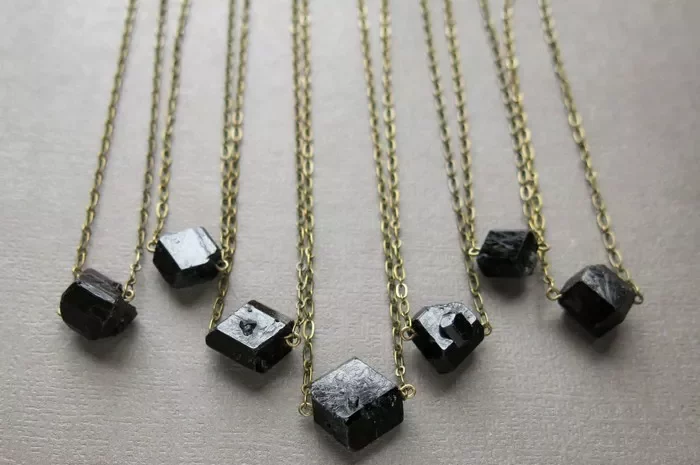In the realm of gemstones, tourmaline stands out as a truly remarkable and versatile mineral. Known for its wide array of colors, from deep greens and blues to vibrant pinks and reds, tourmaline captivates collectors and jewelers alike. Among the various types of tourmaline, fusion tourmaline holds a special place due to its unique characteristics and fascinating formation process. This article aims to delve into the enchanting world of fusion tourmaline, providing a detailed introduction to this gemstone in a popular science style. We’ll explore its composition, formation, color variations, and the allure it holds for both gem enthusiasts and scientists.
What is Fusion Tourmaline?
Fusion tourmaline is a term used to describe a type of tourmaline that results from the merging or intergrowth of two or more distinct tourmaline crystals. This unique phenomenon occurs naturally under specific geological conditions, creating a gemstone with a fascinating and often intricate internal structure. Unlike single-crystal tourmaline, fusion tourmaline showcases a blend of different colors, textures, and patterns, making each piece truly one-of-a-kind.
Composition and Formation
Tourmaline belongs to the borosilicate mineral group, with a complex chemical composition that includes elements such as aluminum, boron, silicon, and oxygen, along with trace amounts of various metals that contribute to its diverse color palette. Fusion tourmaline inherits this complex composition from its constituent crystals, each of which may have slightly different chemical compositions.
The formation of fusion tourmaline begins deep within the Earth’s crust, where molten magma or hot fluids rich in boron, silicon, and other essential elements find their way into fractures and cavities in rocks. Over millions of years, these fluids cool and crystallize, forming the individual tourmaline crystals that eventually merge to create fusion tourmaline.
The precise conditions that lead to the fusion of these crystals are not fully understood but are likely related to changes in temperature, pressure, and the availability of nutrients within the host rock. The result is a gemstone with a fascinating internal structure, often featuring distinct layers, swirls, and patterns that are unique to fusion tourmaline.
Color Variations
One of the most striking features of fusion tourmaline is its diverse color palette. The color of tourmaline is primarily influenced by the presence of trace elements within its crystal structure. For example, chromium can give tourmaline a vibrant green color, while manganese and iron can produce pinks and reds. In fusion tourmaline, the interplay of these elements within the merged crystals results in a breathtaking array of colors and patterns.
Some fusion tourmaline specimens display a striking contrast between two or more colors, creating a striking visual effect. Others may feature a gradual transition from one color to another, creating a mesmerizing gradient. The unique color combinations and patterns found in fusion tourmaline make it a highly sought-after gemstone for jewelry designers and collectors.
Optical Properties and Appearance
Fusion tourmaline’s optical properties also contribute to its allure. Like other tourmaline varieties, fusion tourmaline is trichroic, meaning it exhibits three different colors when viewed under different angles of polarized light. This property is particularly evident in gemstones that have been cut and polished to enhance their optical effects.
The clarity of fusion tourmaline can vary widely, depending on the quality of the individual crystals and the fusion process. Some pieces may be nearly flawless, with a brilliant clarity that allows light to pass through with minimal scattering. Others may contain inclusions, cracks, or other imperfections that add to their unique character and charm.
The cut and polish of fusion tourmaline are crucial in revealing its full potential. Skilled gem cutters work meticulously to bring out the best color, clarity, and brilliance in each piece, often using complex cutting techniques to accentuate the gemstone’s internal structure and color patterns.
Uses and Applications
Fusion tourmaline’s unique beauty and rarity make it a highly prized gemstone for jewelry design. Its diverse color palette and intricate internal structures provide endless possibilities for creativity, allowing jewelers to craft pieces that are as unique as the gemstones themselves.
From simple and elegant solitaire pendants to intricate and intricate multi-stone designs, fusion tourmaline adds a touch of sophistication and mystery to any jewelry collection. Its versatility also makes it a popular choice for custom designs, allowing clients to collaborate with jewelers to create pieces that reflect their personal tastes and styles.
In addition to its use in jewelry, fusion tourmaline is also valued for its healing and metaphysical properties. Many people believe that tourmaline, in general, has the ability to balance and protect the body’s energy fields, and fusion tourmaline, with its unique combination of colors and properties, is thought to offer even greater benefits. While these beliefs are not scientifically proven, they add to the allure and mystique of this remarkable gemstone.
Conclusion
Fusion tourmaline is a gemstone of unique beauty and intrigue, combining the versatility and allure of tourmaline with the fascination of a complex internal structure. Its diverse color palette, intricate patterns, and optical properties make it a highly prized gemstone for jewelry designers, collectors, and anyone who appreciates the wonders of the natural world.
Related topic:
- What Does Pink Tourmaline Do
- What Are the Benefits of Pink Tourmaline
- Is Pink Tourmaline UV Reactive


